Abstract
The Yugoslavia Prospective Study of environmental lead exposure has studied the associations between exposure to lead and pregnancy outcomes; childhood neuropsychological, behavioral, and physical development; and hematologic, renal, and cardiovascular function. The cohort comprises 577 children born to women recruited at midpregnancy in two towns in Kosovo, Yugoslavia; one town is the site of a lead smelter, refinery, and battery plant and the other is 25 miles away and relatively unexposed. A sample of these children has been followed at 6-month intervals through 7.5 years of age. Blood lead concentrations ranged from 1 to 70 microg/dl. Exposure to lead was not associated with adverse pregnancy outcomes. Exposure was associated with modest decrements in intelligence, small increases in blood pressure, higher risks of proteinuria, small increases in behavior problems, and perturbed hematopoiesis. Only at low level exposures (i.e., <16 microg/dl) were small associations with decreased height found. We discuss methodological problems that may hinder causal interpretation of these data, namely, use of blood lead concentration as an exposure measure, confounding, and town-specific associations. We conclude that while reported associations are small, collectively they lend support to the notion that lead is a toxicant with numerous adverse health effects.
Full text
PDF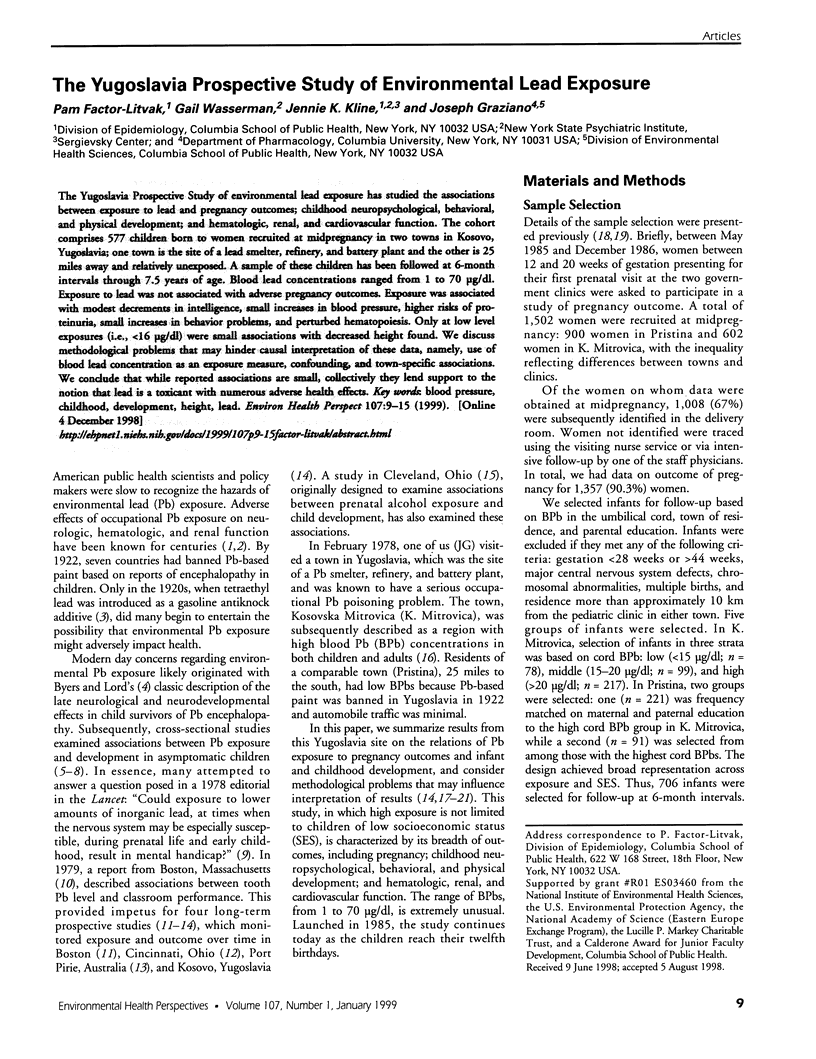
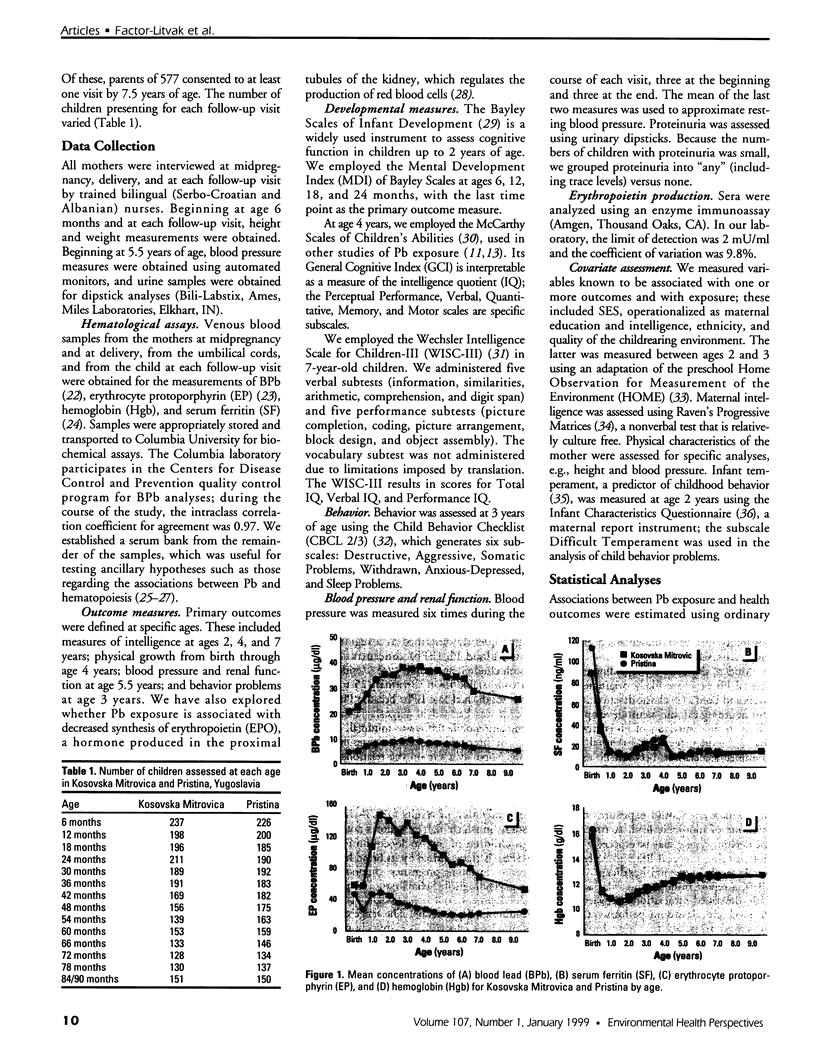
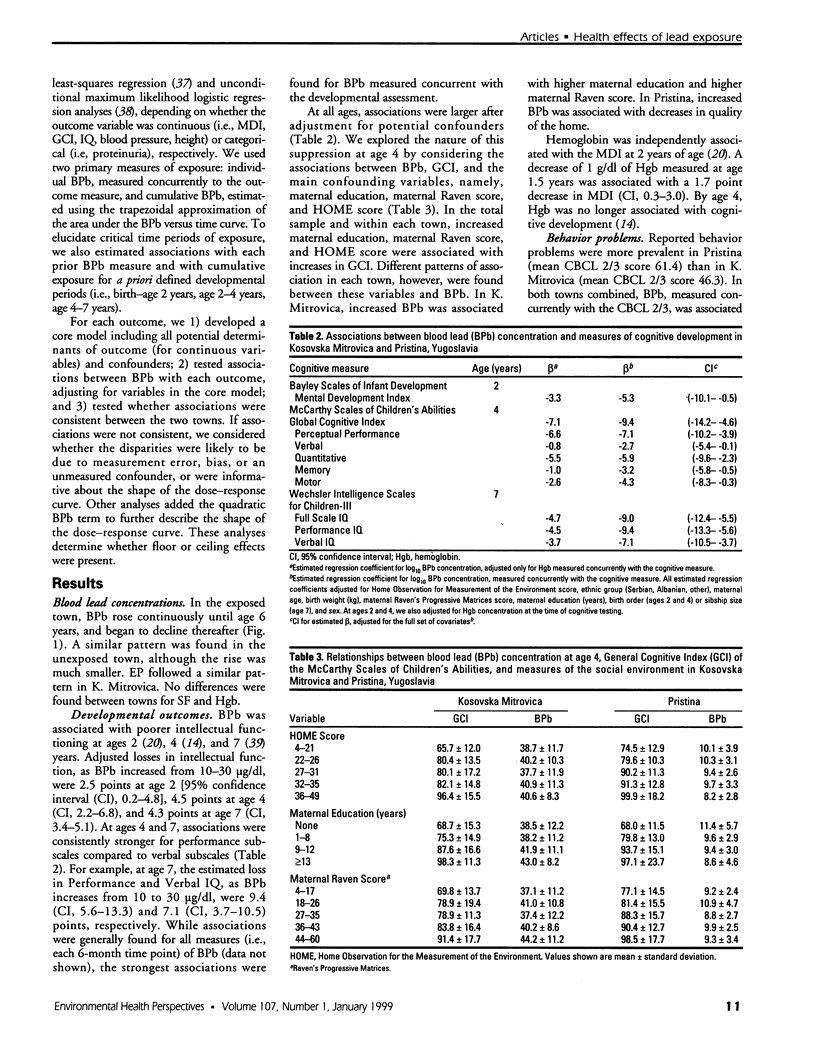
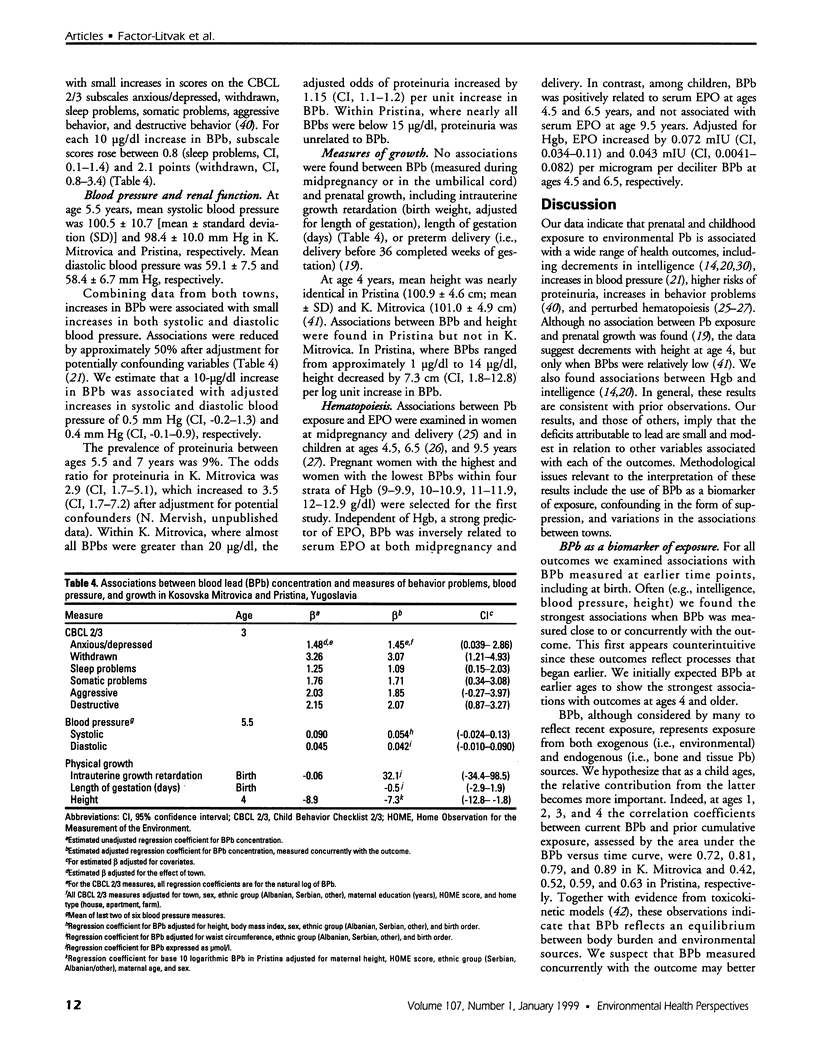
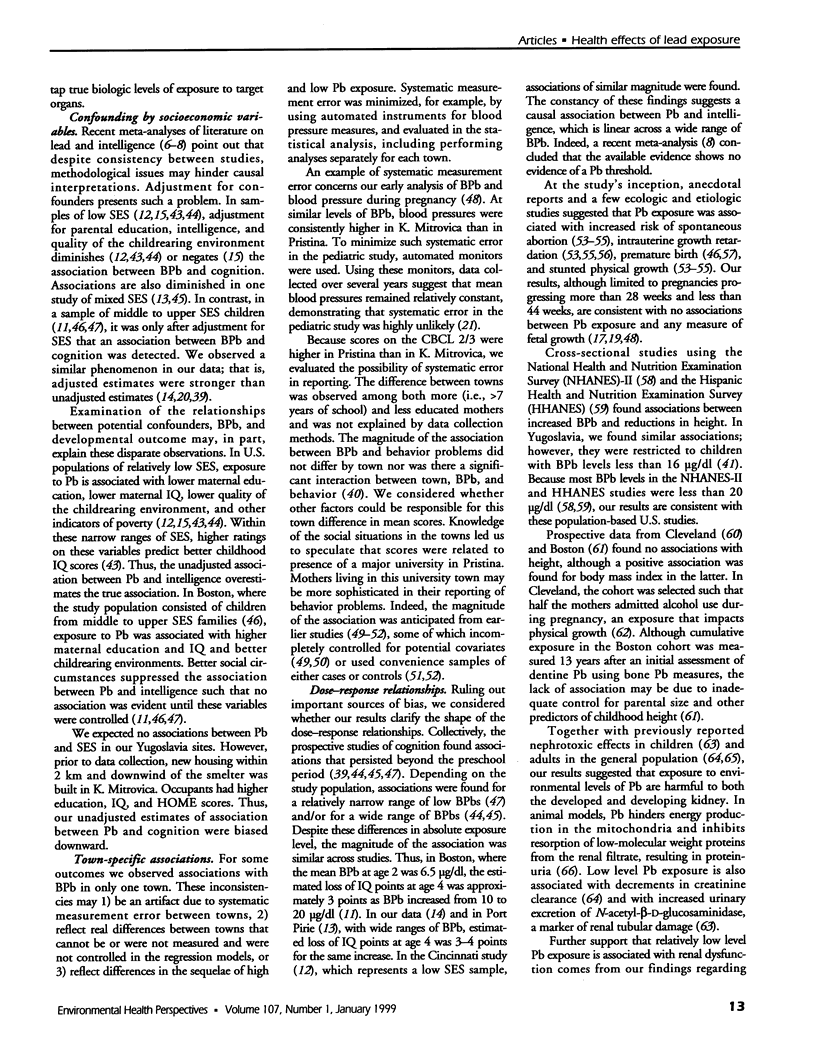
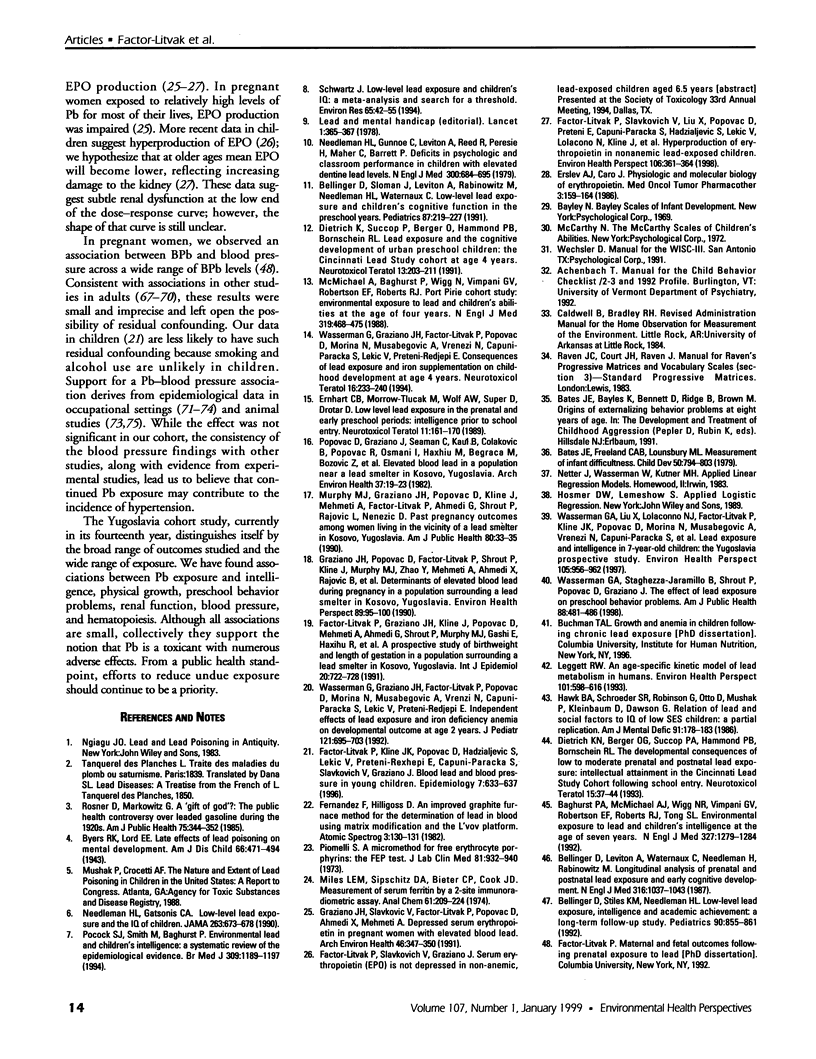
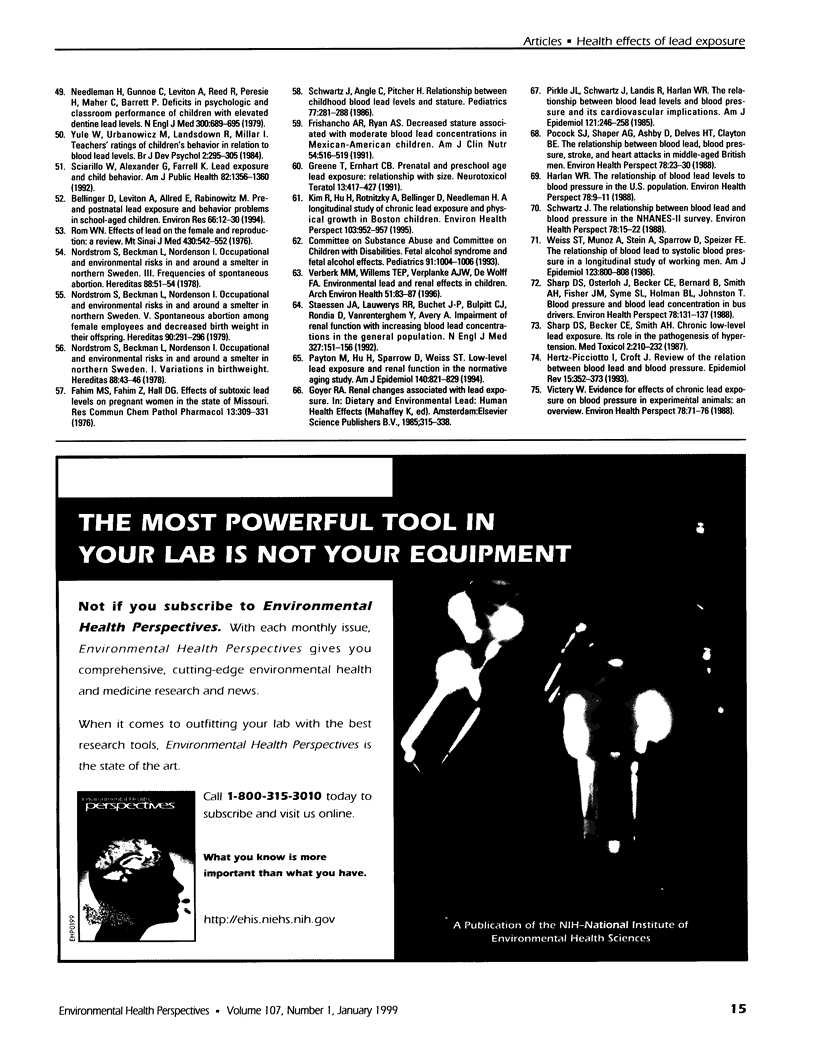
Images in this article
Selected References
These references are in PubMed. This may not be the complete list of references from this article.
- Baghurst P. A., McMichael A. J., Wigg N. R., Vimpani G. V., Robertson E. F., Roberts R. J., Tong S. L. Environmental exposure to lead and children's intelligence at the age of seven years. The Port Pirie Cohort Study. N Engl J Med. 1992 Oct 29;327(18):1279–1284. doi: 10.1056/NEJM199210293271805. [DOI] [PubMed] [Google Scholar]
- Bates J. E., Freeland C. A., Lounsbury M. L. Measurement of infant difficultness. Child Dev. 1979 Sep;50(3):794–803. [PubMed] [Google Scholar]
- Bellinger D. C., Stiles K. M., Needleman H. L. Low-level lead exposure, intelligence and academic achievement: a long-term follow-up study. Pediatrics. 1992 Dec;90(6):855–861. [PubMed] [Google Scholar]
- Bellinger D., Leviton A., Allred E., Rabinowitz M. Pre- and postnatal lead exposure and behavior problems in school-aged children. Environ Res. 1994 Jul;66(1):12–30. doi: 10.1006/enrs.1994.1041. [DOI] [PubMed] [Google Scholar]
- Bellinger D., Leviton A., Waternaux C., Needleman H., Rabinowitz M. Longitudinal analyses of prenatal and postnatal lead exposure and early cognitive development. N Engl J Med. 1987 Apr 23;316(17):1037–1043. doi: 10.1056/NEJM198704233161701. [DOI] [PubMed] [Google Scholar]
- Bellinger D., Sloman J., Leviton A., Rabinowitz M., Needleman H. L., Waternaux C. Low-level lead exposure and children's cognitive function in the preschool years. Pediatrics. 1991 Feb;87(2):219–227. [PubMed] [Google Scholar]
- Dietrich K. N., Berger O. G., Succop P. A., Hammond P. B., Bornschein R. L. The developmental consequences of low to moderate prenatal and postnatal lead exposure: intellectual attainment in the Cincinnati Lead Study Cohort following school entry. Neurotoxicol Teratol. 1993 Jan-Feb;15(1):37–44. doi: 10.1016/0892-0362(93)90043-n. [DOI] [PubMed] [Google Scholar]
- Dietrich K. N., Succop P. A., Berger O. G., Hammond P. B., Bornschein R. L. Lead exposure and the cognitive development of urban preschool children: the Cincinnati Lead Study cohort at age 4 years. Neurotoxicol Teratol. 1991 Mar-Apr;13(2):203–211. doi: 10.1016/0892-0362(91)90012-l. [DOI] [PubMed] [Google Scholar]
- Ernhart C. B., Morrow-Tlucak M., Wolf A. W., Super D., Drotar D. Low level lead exposure in the prenatal and early preschool periods: intelligence prior to school entry. Neurotoxicol Teratol. 1989 Mar-Apr;11(2):161–170. doi: 10.1016/0892-0362(89)90055-x. [DOI] [PubMed] [Google Scholar]
- Erslev A. J., Caro J. Physiologic and molecular biology of erythropoietin. Med Oncol Tumor Pharmacother. 1986;3(3-4):159–164. doi: 10.1007/BF02934992. [DOI] [PubMed] [Google Scholar]
- Factor-Litvak P., Graziano J. H., Kline J. K., Popovac D., Mehmeti A., Ahmedi G., Shrout P., Murphy M. J., Gashi E., Haxhiu R. A prospective study of birthweight and length of gestation in a population surrounding a lead smelter in Kosovo, Yugoslavia. Int J Epidemiol. 1991 Sep;20(3):722–728. doi: 10.1093/ije/20.3.722. [DOI] [PubMed] [Google Scholar]
- Factor-Litvak P., Kline J. K., Popovac D., Hadzialjevic S., Lekic V., Preteni-Rexhepi E., Capuni-Paracka S., Slavkovich V., Graziano J. Blood lead and blood pressure in young children. Epidemiology. 1996 Nov;7(6):633–637. doi: 10.1097/00001648-199611000-00012. [DOI] [PubMed] [Google Scholar]
- Factor-Litvak P., Slavkovich V., Liu X., Popovac D., Preteni E., Capuni-Paracka S., Hadzialjevic S., Lekic V., LoIacono N., Kline J. Hyperproduction of erythropoietin in nonanemic lead-exposed children. Environ Health Perspect. 1998 Jun;106(6):361–364. doi: 10.1289/ehp.98106361. [DOI] [PMC free article] [PubMed] [Google Scholar]
- Fahim M. S., Fahim Z., Hall D. G. Effects of subtoxic lead levels on pregnant women in the state of Missouri. Res Commun Chem Pathol Pharmacol. 1976 Feb;13(2):309–331. [PubMed] [Google Scholar]
- Frisancho A. R., Ryan A. S. Decreased stature associated with moderate blood lead concentrations in Mexican-American children. Am J Clin Nutr. 1991 Sep;54(3):516–519. doi: 10.1093/ajcn/54.3.516. [DOI] [PubMed] [Google Scholar]
- Graziano J. H., Popovac D., Factor-Litvak P., Shrout P., Kline J., Murphy M. J., Zhao Y. H., Mehmeti A., Ahmedi X., Rajovic B. Determinants of elevated blood lead during pregnancy in a population surrounding a lead smelter in Kosovo, Yugoslavia. Environ Health Perspect. 1990 Nov;89:95–100. doi: 10.1289/ehp.908995. [DOI] [PMC free article] [PubMed] [Google Scholar]
- Graziano J. H., Slavkovic V., Factor-Litvak P., Popovac D., Ahmedi X., Mehmeti A. Depressed serum erythropoietin in pregnant women with elevated blood lead. Arch Environ Health. 1991 Nov-Dec;46(6):347–350. doi: 10.1080/00039896.1991.9934401. [DOI] [PubMed] [Google Scholar]
- Greene T., Ernhart C. B. Prenatal and preschool age lead exposure: relationship with size. Neurotoxicol Teratol. 1991 Jul-Aug;13(4):417–427. doi: 10.1016/0892-0362(91)90091-a. [DOI] [PubMed] [Google Scholar]
- Harlan W. R. The relationship of blood lead levels to blood pressure in the U.S. population. Environ Health Perspect. 1988 Jun;78:9–13. doi: 10.1289/ehp.88789. [DOI] [PMC free article] [PubMed] [Google Scholar]
- Hawk B. A., Schroeder S. R., Robinson G., Otto D., Mushak P., Kleinbaum D., Dawson G. Relation of lead and social factors to IQ of low-SES children: a partial replication. Am J Ment Defic. 1986 Sep;91(2):178–183. [PubMed] [Google Scholar]
- Hertz-Picciotto I., Croft J. Review of the relation between blood lead and blood pressure. Epidemiol Rev. 1993;15(2):352–373. doi: 10.1093/oxfordjournals.epirev.a036125. [DOI] [PubMed] [Google Scholar]
- Kim R., Hu H., Rotnitzky A., Bellinger D., Needleman H. A longitudinal study of chronic lead exposure and physical growth in Boston children. Environ Health Perspect. 1995 Oct;103(10):952–957. doi: 10.1289/ehp.95103952. [DOI] [PMC free article] [PubMed] [Google Scholar]
- Leggett R. W. An age-specific kinetic model of lead metabolism in humans. Environ Health Perspect. 1993 Dec;101(7):598–616. doi: 10.1289/ehp.93101598. [DOI] [PMC free article] [PubMed] [Google Scholar]
- McMichael A. J., Baghurst P. A., Wigg N. R., Vimpani G. V., Robertson E. F., Roberts R. J. Port Pirie Cohort Study: environmental exposure to lead and children's abilities at the age of four years. N Engl J Med. 1988 Aug 25;319(8):468–475. doi: 10.1056/NEJM198808253190803. [DOI] [PubMed] [Google Scholar]
- Miles L. E., Lipschitz D. A., Bieber C. P., Cook J. D. Measurement of serum ferritin by a 2-site immunoradiometric assay. Anal Biochem. 1974 Sep;61(1):209–224. doi: 10.1016/0003-2697(74)90347-9. [DOI] [PubMed] [Google Scholar]
- Murphy M. J., Graziano J. H., Popovac D., Kline J. K., Mehmeti A., Factor-Litvak P., Ahmedi G., Shrout P., Rajovic B., Nenezic D. U. Past pregnancy outcomes among women living in the vicinity of a lead smelter in Kosovo, Yugoslavia. Am J Public Health. 1990 Jan;80(1):33–35. doi: 10.2105/ajph.80.1.33. [DOI] [PMC free article] [PubMed] [Google Scholar]
- Needleman H. L., Gatsonis C. A. Low-level lead exposure and the IQ of children. A meta-analysis of modern studies. JAMA. 1990 Feb 2;263(5):673–678. [PubMed] [Google Scholar]
- Needleman H. L., Gunnoe C., Leviton A., Reed R., Peresie H., Maher C., Barrett P. Deficits in psychologic and classroom performance of children with elevated dentine lead levels. N Engl J Med. 1979 Mar 29;300(13):689–695. doi: 10.1056/NEJM197903293001301. [DOI] [PubMed] [Google Scholar]
- Needleman H. L., Gunnoe C., Leviton A., Reed R., Peresie H., Maher C., Barrett P. Deficits in psychologic and classroom performance of children with elevated dentine lead levels. N Engl J Med. 1979 Mar 29;300(13):689–695. doi: 10.1056/NEJM197903293001301. [DOI] [PubMed] [Google Scholar]
- Nordström S., Beckman L., Nordenson I. Occupational and environmental risks in and around a smelter in northern Sweden. I. Variations in birth weight. Hereditas. 1978;88(1):43–46. doi: 10.1111/j.1601-5223.1978.tb01600.x. [DOI] [PubMed] [Google Scholar]
- Nordström S., Beckman L., Nordenson I. Occupational and environmental risks in and around a smelter in northern Sweden. III. Frequencies of spontaneous abortion. Hereditas. 1978;88(1):51–54. doi: 10.1111/j.1601-5223.1978.tb01602.x. [DOI] [PubMed] [Google Scholar]
- Nordström S., Beckman L., Nordenson I. Occupational and environmental risks in and around a smelter in northern Sweden. V. Spontaneous abortion among female employees and decreased birth weight in their offspring. Hereditas. 1979;90(2):291–296. [PubMed] [Google Scholar]
- Payton M., Hu H., Sparrow D., Weiss S. T. Low-level lead exposure and renal function in the Normative Aging Study. Am J Epidemiol. 1994 Nov 1;140(9):821–829. doi: 10.1093/oxfordjournals.aje.a117330. [DOI] [PubMed] [Google Scholar]
- Piomelli S. A micromethod for free erythrocyte porphyrins: the FEP test. J Lab Clin Med. 1973 Jun;81(6):932–940. [PubMed] [Google Scholar]
- Pirkle J. L., Schwartz J., Landis J. R., Harlan W. R. The relationship between blood lead levels and blood pressure and its cardiovascular risk implications. Am J Epidemiol. 1985 Feb;121(2):246–258. doi: 10.1093/oxfordjournals.aje.a113995. [DOI] [PubMed] [Google Scholar]
- Pocock S. J., Smith M., Baghurst P. Environmental lead and children's intelligence: a systematic review of the epidemiological evidence. BMJ. 1994 Nov 5;309(6963):1189–1197. doi: 10.1136/bmj.309.6963.1189. [DOI] [PMC free article] [PubMed] [Google Scholar]
- Popovac D., Graziano J., Seaman C., Colakovic B., Popovac R., Osmani I., Haxhiu M., Begraca M., Bozovic Z., Mikic M. Elevated blood lead in a population near a lead smelter in Kosovo, Yugoslavia. Arch Environ Health. 1982 Jan-Feb;37(1):19–23. doi: 10.1080/00039896.1982.10667527. [DOI] [PubMed] [Google Scholar]
- Rom W. N. Effects of lead on the female and reproduction: a review. Mt Sinai J Med. 1976 Sep-Oct;43(5):542–552. [PubMed] [Google Scholar]
- Rosner D., Markowitz G. A 'gift of God'?: The public health controversy over leaded gasoline during the 1920s. Am J Public Health. 1985 Apr;75(4):344–352. doi: 10.2105/ajph.75.4.344. [DOI] [PMC free article] [PubMed] [Google Scholar]
- Schwartz J., Angle C., Pitcher H. Relationship between childhood blood lead levels and stature. Pediatrics. 1986 Mar;77(3):281–288. [PubMed] [Google Scholar]
- Schwartz J. Low-level lead exposure and children's IQ: a meta-analysis and search for a threshold. Environ Res. 1994 Apr;65(1):42–55. doi: 10.1006/enrs.1994.1020. [DOI] [PubMed] [Google Scholar]
- Sciarillo W. G., Alexander G., Farrell K. P. Lead exposure and child behavior. Am J Public Health. 1992 Oct;82(10):1356–1360. doi: 10.2105/ajph.82.10.1356. [DOI] [PMC free article] [PubMed] [Google Scholar]
- Sharp D. S., Becker C. E., Smith A. H. Chronic low-level lead exposure. Its role in the pathogenesis of hypertension. Med Toxicol. 1987 May-Jun;2(3):210–232. doi: 10.1007/BF03259865. [DOI] [PubMed] [Google Scholar]
- Staessen J. A., Lauwerys R. R., Buchet J. P., Bulpitt C. J., Rondia D., Vanrenterghem Y., Amery A. Impairment of renal function with increasing blood lead concentrations in the general population. The Cadmibel Study Group. N Engl J Med. 1992 Jul 16;327(3):151–156. doi: 10.1056/NEJM199207163270303. [DOI] [PubMed] [Google Scholar]
- Verberk M. M., Willems T. E., Verplanke A. J., De Wolff F. A. Environmental lead and renal effects in children. Arch Environ Health. 1996 Jan-Feb;51(1):83–87. doi: 10.1080/00039896.1996.9935998. [DOI] [PubMed] [Google Scholar]
- Victery W. Evidence for effects of chronic lead exposure on blood pressure in experimental animals: an overview. Environ Health Perspect. 1988 Jun;78:71–76. doi: 10.1289/ehp.887871. [DOI] [PMC free article] [PubMed] [Google Scholar]
- Wasserman G. A., Graziano J. H., Factor-Litvak P., Popovac D., Morina N., Musabegovic A., Vrenezi N., Capuni-Paracka S., Lekic V., Preteni-Redjepi E. Consequences of lead exposure and iron supplementation on childhood development at age 4 years. Neurotoxicol Teratol. 1994 May-Jun;16(3):233–240. doi: 10.1016/0892-0362(94)90044-2. [DOI] [PubMed] [Google Scholar]
- Wasserman G. A., Liu X., Lolacono N. J., Factor-Litvak P., Kline J. K., Popovac D., Morina N., Musabegovic A., Vrenezi N., Capuni-Paracka S. Lead exposure and intelligence in 7-year-old children: the Yugoslavia Prospective Study. Environ Health Perspect. 1997 Sep;105(9):956–962. doi: 10.1289/ehp.97105956. [DOI] [PMC free article] [PubMed] [Google Scholar]
- Wasserman G. A., Staghezza-Jaramillo B., Shrout P., Popovac D., Graziano J. The effect of lead exposure on behavior problems in preschool children. Am J Public Health. 1998 Mar;88(3):481–486. doi: 10.2105/ajph.88.3.481. [DOI] [PMC free article] [PubMed] [Google Scholar]
- Wasserman G., Graziano J. H., Factor-Litvak P., Popovac D., Morina N., Musabegovic A., Vrenezi N., Capuni-Paracka S., Lekic V., Preteni-Redjepi E. Independent effects of lead exposure and iron deficiency anemia on developmental outcome at age 2 years. J Pediatr. 1992 Nov;121(5 Pt 1):695–703. doi: 10.1016/s0022-3476(05)81895-5. [DOI] [PubMed] [Google Scholar]
- Weiss S. T., Muñoz A., Stein A., Sparrow D., Speizer F. E. The relationship of blood lead to blood pressure in a longitudinal study of working men. Am J Epidemiol. 1986 May;123(5):800–808. doi: 10.1093/oxfordjournals.aje.a114309. [DOI] [PubMed] [Google Scholar]



